PROJ6009 Business Process Management Plan: Analysis & Improvement
VerifiedAdded on 2023/06/10
|7
|1684
|266
Report
AI Summary
This report provides an overview of Business Process Management (BPM) and its crucial role in enhancing organizational competitiveness. It highlights the significance of BPM in streamlining processes, particularly within Supply Chain Management (SCM). The report details the benefits of BPM, including improved productivity, agility, efficiency, customer orientation, employee satisfaction, consistency, technology integration, measurability, transparency, and compliance. It explores various BPM approaches such as workflow-oriented and document-oriented BPM, while also addressing the risks associated with BPM implementation, such as workforce inertia and integration failure. The report references key studies and literature to support its analysis of BPM's impact on modern businesses.
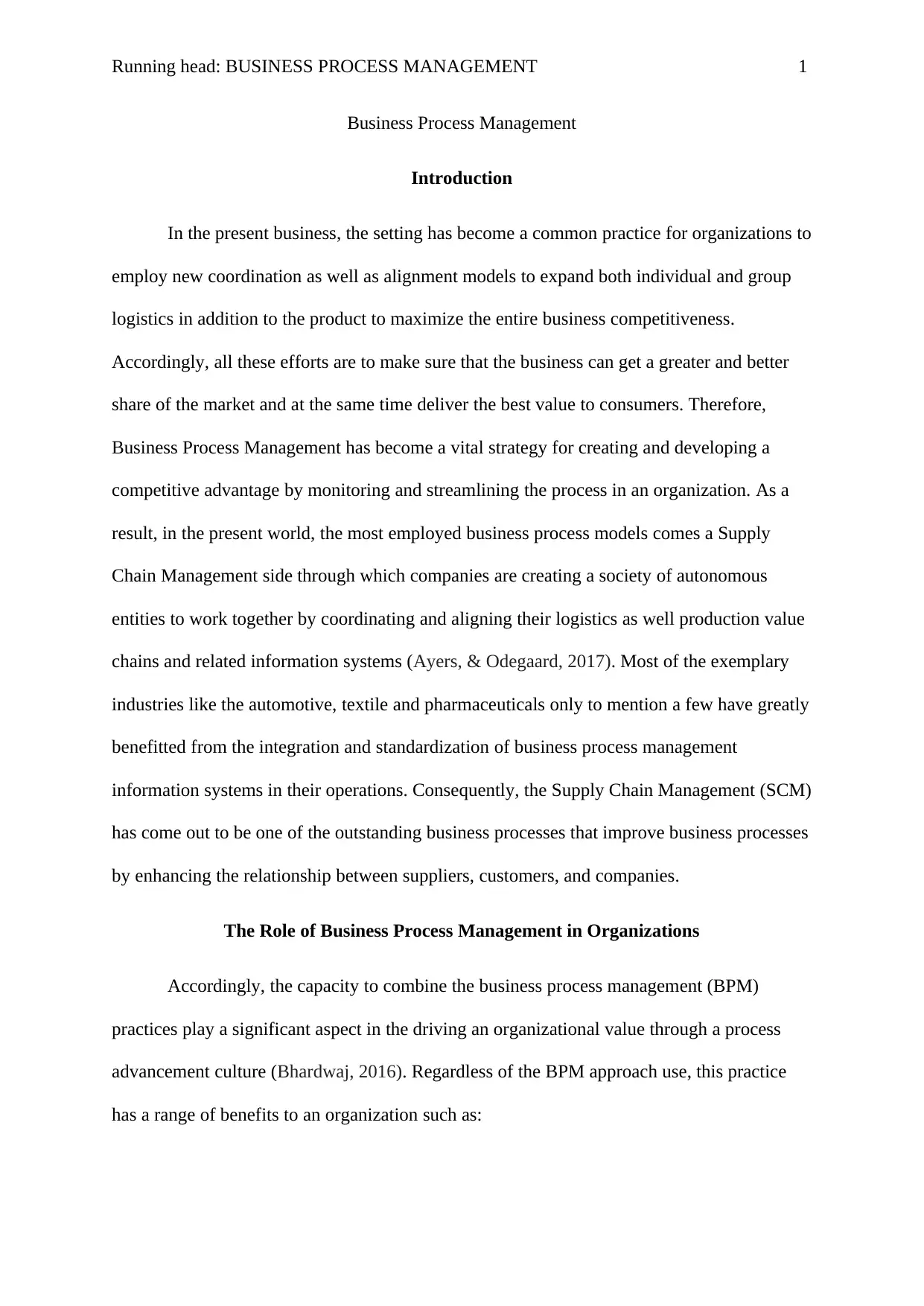
Running head: BUSINESS PROCESS MANAGEMENT 1
Business Process Management
Introduction
In the present business, the setting has become a common practice for organizations to
employ new coordination as well as alignment models to expand both individual and group
logistics in addition to the product to maximize the entire business competitiveness.
Accordingly, all these efforts are to make sure that the business can get a greater and better
share of the market and at the same time deliver the best value to consumers. Therefore,
Business Process Management has become a vital strategy for creating and developing a
competitive advantage by monitoring and streamlining the process in an organization. As a
result, in the present world, the most employed business process models comes a Supply
Chain Management side through which companies are creating a society of autonomous
entities to work together by coordinating and aligning their logistics as well production value
chains and related information systems (Ayers, & Odegaard, 2017). Most of the exemplary
industries like the automotive, textile and pharmaceuticals only to mention a few have greatly
benefitted from the integration and standardization of business process management
information systems in their operations. Consequently, the Supply Chain Management (SCM)
has come out to be one of the outstanding business processes that improve business processes
by enhancing the relationship between suppliers, customers, and companies.
The Role of Business Process Management in Organizations
Accordingly, the capacity to combine the business process management (BPM)
practices play a significant aspect in the driving an organizational value through a process
advancement culture (Bhardwaj, 2016). Regardless of the BPM approach use, this practice
has a range of benefits to an organization such as:
Business Process Management
Introduction
In the present business, the setting has become a common practice for organizations to
employ new coordination as well as alignment models to expand both individual and group
logistics in addition to the product to maximize the entire business competitiveness.
Accordingly, all these efforts are to make sure that the business can get a greater and better
share of the market and at the same time deliver the best value to consumers. Therefore,
Business Process Management has become a vital strategy for creating and developing a
competitive advantage by monitoring and streamlining the process in an organization. As a
result, in the present world, the most employed business process models comes a Supply
Chain Management side through which companies are creating a society of autonomous
entities to work together by coordinating and aligning their logistics as well production value
chains and related information systems (Ayers, & Odegaard, 2017). Most of the exemplary
industries like the automotive, textile and pharmaceuticals only to mention a few have greatly
benefitted from the integration and standardization of business process management
information systems in their operations. Consequently, the Supply Chain Management (SCM)
has come out to be one of the outstanding business processes that improve business processes
by enhancing the relationship between suppliers, customers, and companies.
The Role of Business Process Management in Organizations
Accordingly, the capacity to combine the business process management (BPM)
practices play a significant aspect in the driving an organizational value through a process
advancement culture (Bhardwaj, 2016). Regardless of the BPM approach use, this practice
has a range of benefits to an organization such as:
Paraphrase This Document
Need a fresh take? Get an instant paraphrase of this document with our AI Paraphraser
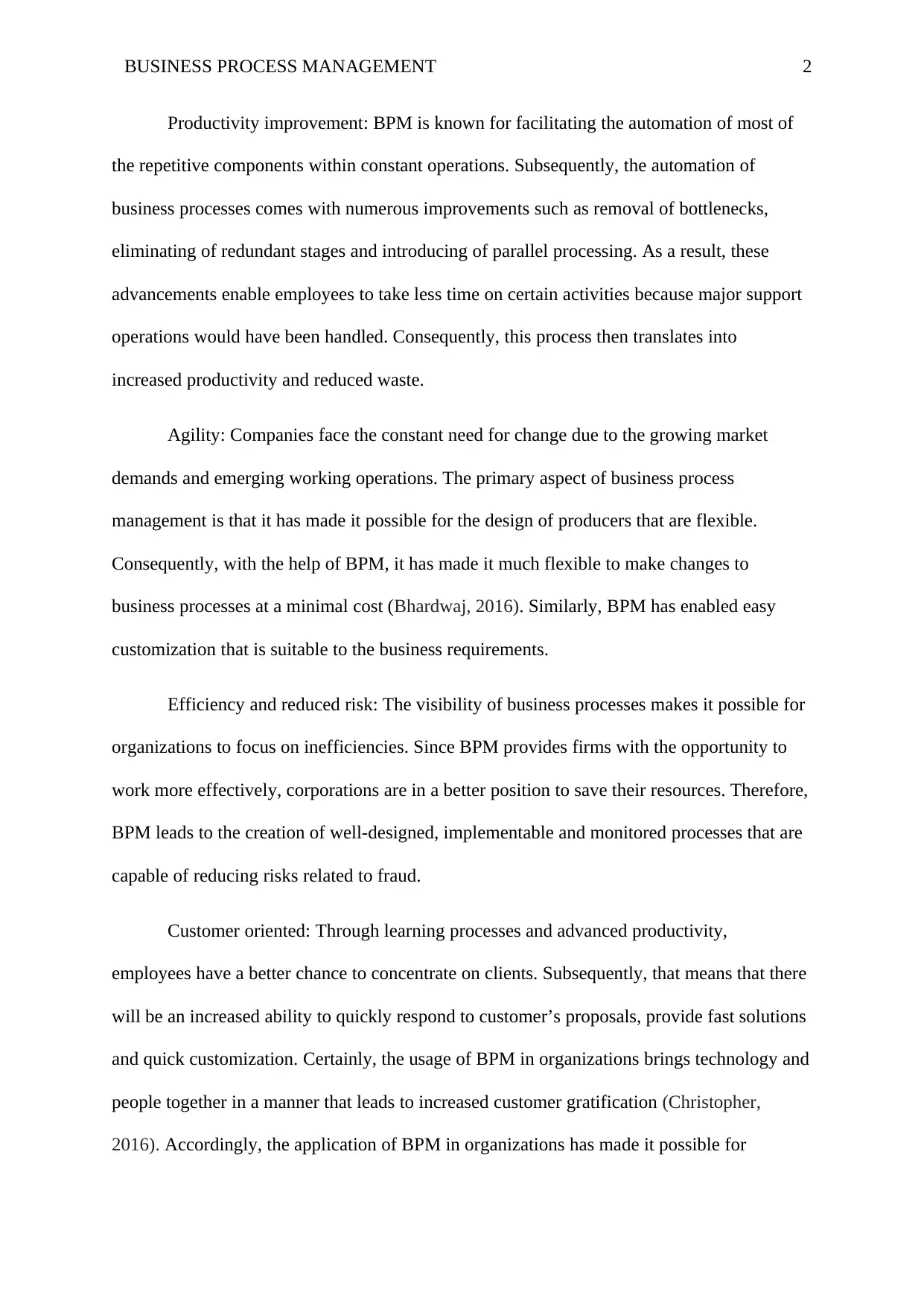
BUSINESS PROCESS MANAGEMENT 2
Productivity improvement: BPM is known for facilitating the automation of most of
the repetitive components within constant operations. Subsequently, the automation of
business processes comes with numerous improvements such as removal of bottlenecks,
eliminating of redundant stages and introducing of parallel processing. As a result, these
advancements enable employees to take less time on certain activities because major support
operations would have been handled. Consequently, this process then translates into
increased productivity and reduced waste.
Agility: Companies face the constant need for change due to the growing market
demands and emerging working operations. The primary aspect of business process
management is that it has made it possible for the design of producers that are flexible.
Consequently, with the help of BPM, it has made it much flexible to make changes to
business processes at a minimal cost (Bhardwaj, 2016). Similarly, BPM has enabled easy
customization that is suitable to the business requirements.
Efficiency and reduced risk: The visibility of business processes makes it possible for
organizations to focus on inefficiencies. Since BPM provides firms with the opportunity to
work more effectively, corporations are in a better position to save their resources. Therefore,
BPM leads to the creation of well-designed, implementable and monitored processes that are
capable of reducing risks related to fraud.
Customer oriented: Through learning processes and advanced productivity,
employees have a better chance to concentrate on clients. Subsequently, that means that there
will be an increased ability to quickly respond to customer’s proposals, provide fast solutions
and quick customization. Certainly, the usage of BPM in organizations brings technology and
people together in a manner that leads to increased customer gratification (Christopher,
2016). Accordingly, the application of BPM in organizations has made it possible for
Productivity improvement: BPM is known for facilitating the automation of most of
the repetitive components within constant operations. Subsequently, the automation of
business processes comes with numerous improvements such as removal of bottlenecks,
eliminating of redundant stages and introducing of parallel processing. As a result, these
advancements enable employees to take less time on certain activities because major support
operations would have been handled. Consequently, this process then translates into
increased productivity and reduced waste.
Agility: Companies face the constant need for change due to the growing market
demands and emerging working operations. The primary aspect of business process
management is that it has made it possible for the design of producers that are flexible.
Consequently, with the help of BPM, it has made it much flexible to make changes to
business processes at a minimal cost (Bhardwaj, 2016). Similarly, BPM has enabled easy
customization that is suitable to the business requirements.
Efficiency and reduced risk: The visibility of business processes makes it possible for
organizations to focus on inefficiencies. Since BPM provides firms with the opportunity to
work more effectively, corporations are in a better position to save their resources. Therefore,
BPM leads to the creation of well-designed, implementable and monitored processes that are
capable of reducing risks related to fraud.
Customer oriented: Through learning processes and advanced productivity,
employees have a better chance to concentrate on clients. Subsequently, that means that there
will be an increased ability to quickly respond to customer’s proposals, provide fast solutions
and quick customization. Certainly, the usage of BPM in organizations brings technology and
people together in a manner that leads to increased customer gratification (Christopher,
2016). Accordingly, the application of BPM in organizations has made it possible for
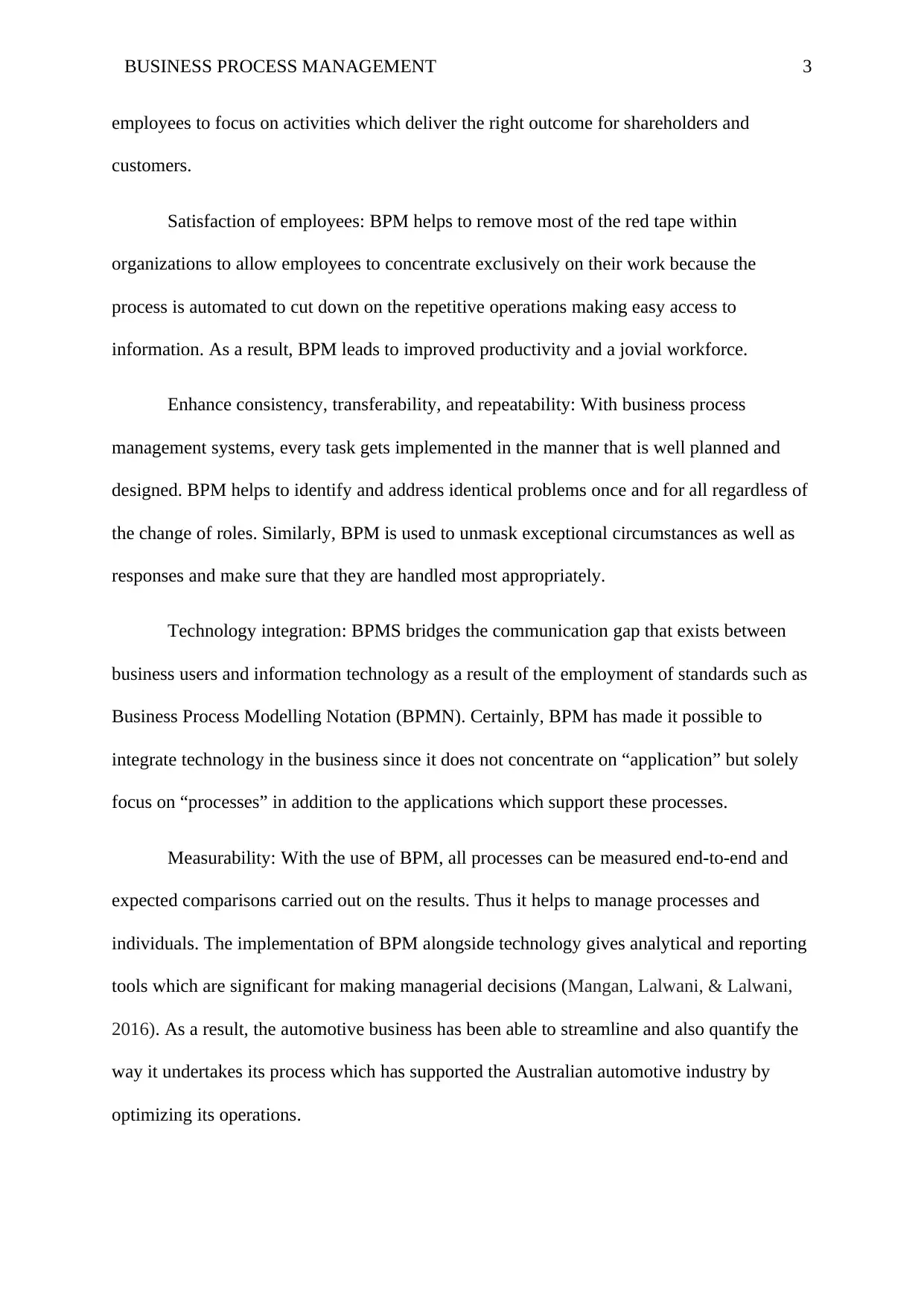
BUSINESS PROCESS MANAGEMENT 3
employees to focus on activities which deliver the right outcome for shareholders and
customers.
Satisfaction of employees: BPM helps to remove most of the red tape within
organizations to allow employees to concentrate exclusively on their work because the
process is automated to cut down on the repetitive operations making easy access to
information. As a result, BPM leads to improved productivity and a jovial workforce.
Enhance consistency, transferability, and repeatability: With business process
management systems, every task gets implemented in the manner that is well planned and
designed. BPM helps to identify and address identical problems once and for all regardless of
the change of roles. Similarly, BPM is used to unmask exceptional circumstances as well as
responses and make sure that they are handled most appropriately.
Technology integration: BPMS bridges the communication gap that exists between
business users and information technology as a result of the employment of standards such as
Business Process Modelling Notation (BPMN). Certainly, BPM has made it possible to
integrate technology in the business since it does not concentrate on “application” but solely
focus on “processes” in addition to the applications which support these processes.
Measurability: With the use of BPM, all processes can be measured end-to-end and
expected comparisons carried out on the results. Thus it helps to manage processes and
individuals. The implementation of BPM alongside technology gives analytical and reporting
tools which are significant for making managerial decisions (Mangan, Lalwani, & Lalwani,
2016). As a result, the automotive business has been able to streamline and also quantify the
way it undertakes its process which has supported the Australian automotive industry by
optimizing its operations.
employees to focus on activities which deliver the right outcome for shareholders and
customers.
Satisfaction of employees: BPM helps to remove most of the red tape within
organizations to allow employees to concentrate exclusively on their work because the
process is automated to cut down on the repetitive operations making easy access to
information. As a result, BPM leads to improved productivity and a jovial workforce.
Enhance consistency, transferability, and repeatability: With business process
management systems, every task gets implemented in the manner that is well planned and
designed. BPM helps to identify and address identical problems once and for all regardless of
the change of roles. Similarly, BPM is used to unmask exceptional circumstances as well as
responses and make sure that they are handled most appropriately.
Technology integration: BPMS bridges the communication gap that exists between
business users and information technology as a result of the employment of standards such as
Business Process Modelling Notation (BPMN). Certainly, BPM has made it possible to
integrate technology in the business since it does not concentrate on “application” but solely
focus on “processes” in addition to the applications which support these processes.
Measurability: With the use of BPM, all processes can be measured end-to-end and
expected comparisons carried out on the results. Thus it helps to manage processes and
individuals. The implementation of BPM alongside technology gives analytical and reporting
tools which are significant for making managerial decisions (Mangan, Lalwani, & Lalwani,
2016). As a result, the automotive business has been able to streamline and also quantify the
way it undertakes its process which has supported the Australian automotive industry by
optimizing its operations.
⊘ This is a preview!⊘
Do you want full access?
Subscribe today to unlock all pages.

Trusted by 1+ million students worldwide
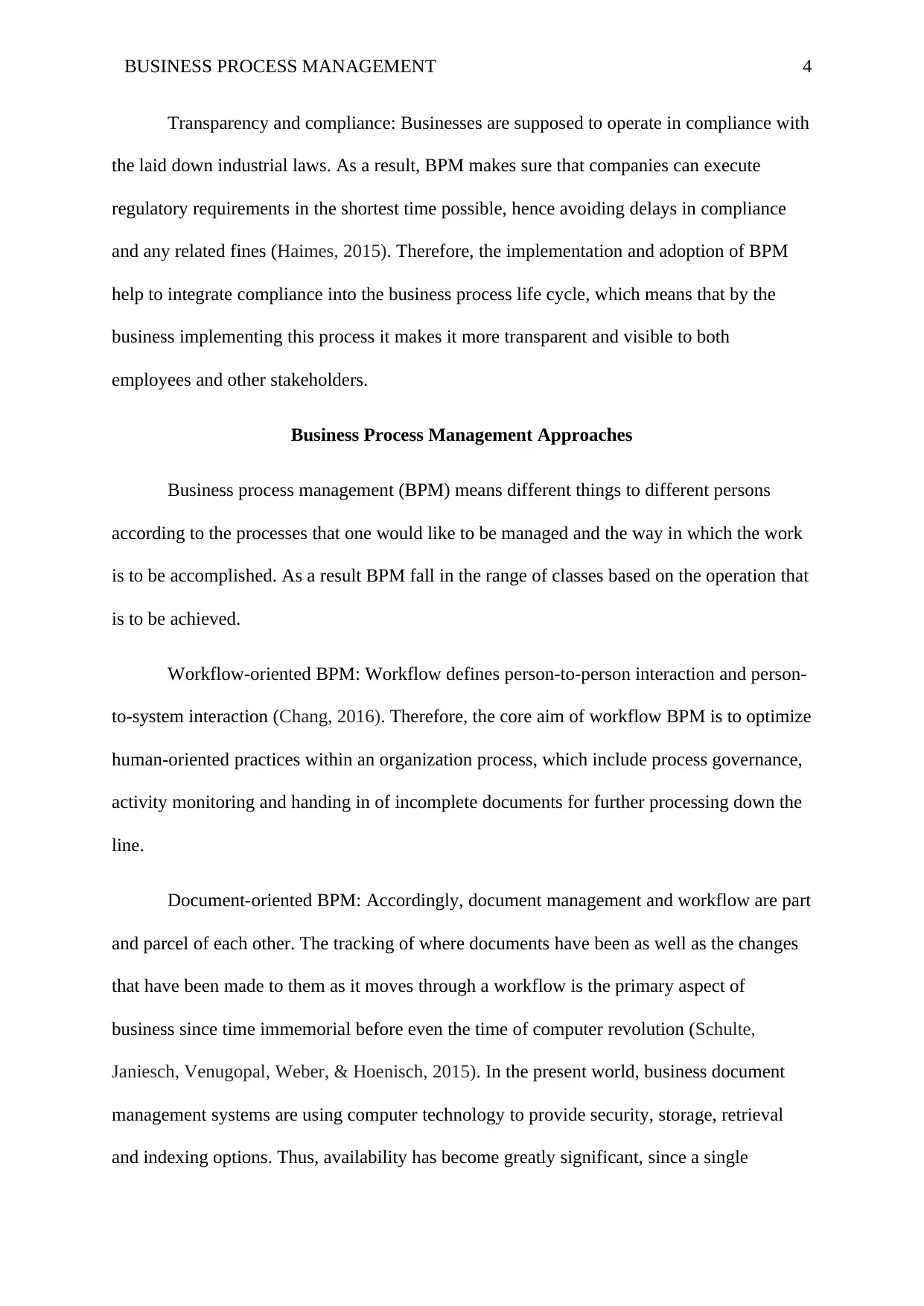
BUSINESS PROCESS MANAGEMENT 4
Transparency and compliance: Businesses are supposed to operate in compliance with
the laid down industrial laws. As a result, BPM makes sure that companies can execute
regulatory requirements in the shortest time possible, hence avoiding delays in compliance
and any related fines (Haimes, 2015). Therefore, the implementation and adoption of BPM
help to integrate compliance into the business process life cycle, which means that by the
business implementing this process it makes it more transparent and visible to both
employees and other stakeholders.
Business Process Management Approaches
Business process management (BPM) means different things to different persons
according to the processes that one would like to be managed and the way in which the work
is to be accomplished. As a result BPM fall in the range of classes based on the operation that
is to be achieved.
Workflow-oriented BPM: Workflow defines person-to-person interaction and person-
to-system interaction (Chang, 2016). Therefore, the core aim of workflow BPM is to optimize
human-oriented practices within an organization process, which include process governance,
activity monitoring and handing in of incomplete documents for further processing down the
line.
Document-oriented BPM: Accordingly, document management and workflow are part
and parcel of each other. The tracking of where documents have been as well as the changes
that have been made to them as it moves through a workflow is the primary aspect of
business since time immemorial before even the time of computer revolution (Schulte,
Janiesch, Venugopal, Weber, & Hoenisch, 2015). In the present world, business document
management systems are using computer technology to provide security, storage, retrieval
and indexing options. Thus, availability has become greatly significant, since a single
Transparency and compliance: Businesses are supposed to operate in compliance with
the laid down industrial laws. As a result, BPM makes sure that companies can execute
regulatory requirements in the shortest time possible, hence avoiding delays in compliance
and any related fines (Haimes, 2015). Therefore, the implementation and adoption of BPM
help to integrate compliance into the business process life cycle, which means that by the
business implementing this process it makes it more transparent and visible to both
employees and other stakeholders.
Business Process Management Approaches
Business process management (BPM) means different things to different persons
according to the processes that one would like to be managed and the way in which the work
is to be accomplished. As a result BPM fall in the range of classes based on the operation that
is to be achieved.
Workflow-oriented BPM: Workflow defines person-to-person interaction and person-
to-system interaction (Chang, 2016). Therefore, the core aim of workflow BPM is to optimize
human-oriented practices within an organization process, which include process governance,
activity monitoring and handing in of incomplete documents for further processing down the
line.
Document-oriented BPM: Accordingly, document management and workflow are part
and parcel of each other. The tracking of where documents have been as well as the changes
that have been made to them as it moves through a workflow is the primary aspect of
business since time immemorial before even the time of computer revolution (Schulte,
Janiesch, Venugopal, Weber, & Hoenisch, 2015). In the present world, business document
management systems are using computer technology to provide security, storage, retrieval
and indexing options. Thus, availability has become greatly significant, since a single
Paraphrase This Document
Need a fresh take? Get an instant paraphrase of this document with our AI Paraphraser
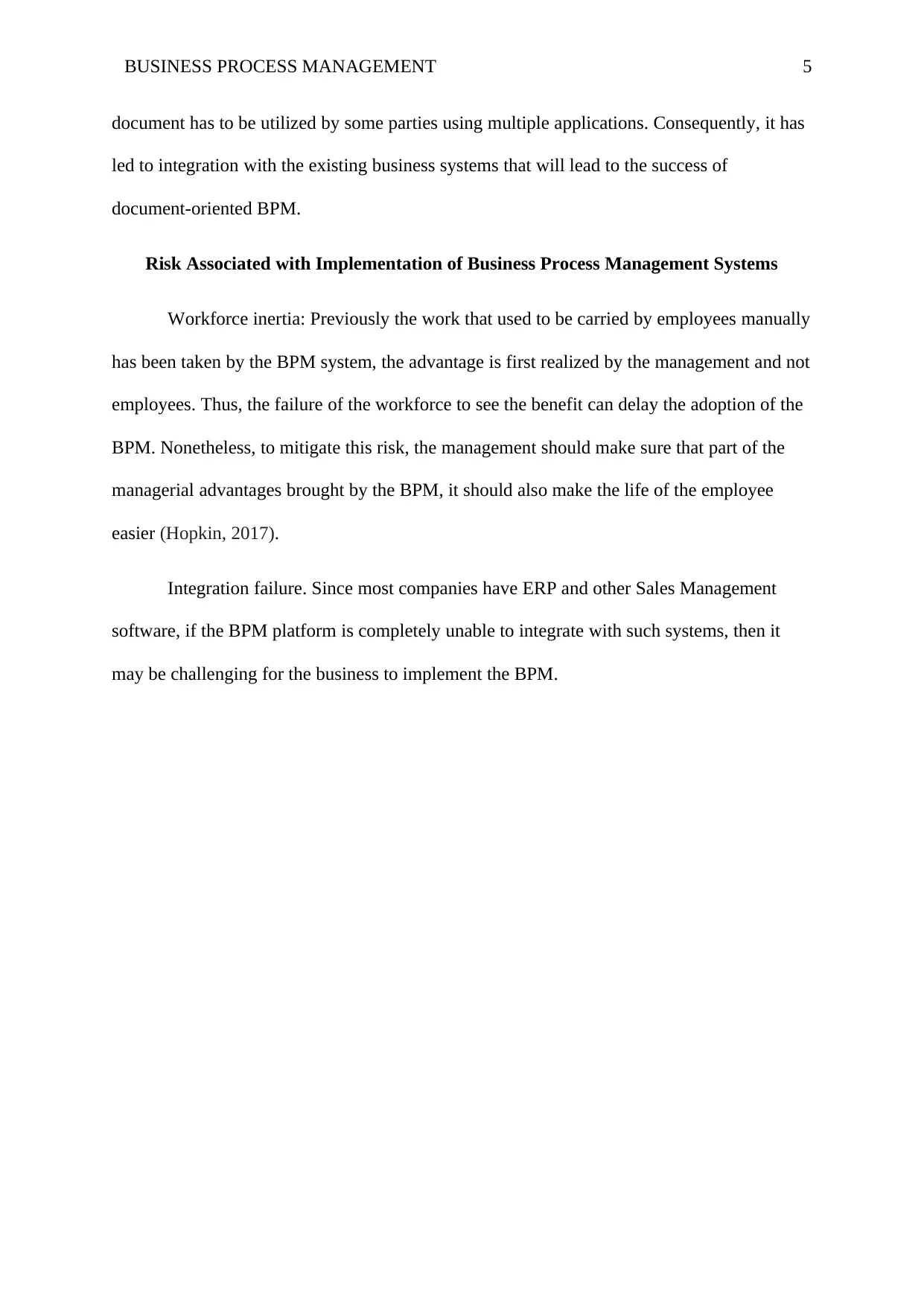
BUSINESS PROCESS MANAGEMENT 5
document has to be utilized by some parties using multiple applications. Consequently, it has
led to integration with the existing business systems that will lead to the success of
document-oriented BPM.
Risk Associated with Implementation of Business Process Management Systems
Workforce inertia: Previously the work that used to be carried by employees manually
has been taken by the BPM system, the advantage is first realized by the management and not
employees. Thus, the failure of the workforce to see the benefit can delay the adoption of the
BPM. Nonetheless, to mitigate this risk, the management should make sure that part of the
managerial advantages brought by the BPM, it should also make the life of the employee
easier (Hopkin, 2017).
Integration failure. Since most companies have ERP and other Sales Management
software, if the BPM platform is completely unable to integrate with such systems, then it
may be challenging for the business to implement the BPM.
document has to be utilized by some parties using multiple applications. Consequently, it has
led to integration with the existing business systems that will lead to the success of
document-oriented BPM.
Risk Associated with Implementation of Business Process Management Systems
Workforce inertia: Previously the work that used to be carried by employees manually
has been taken by the BPM system, the advantage is first realized by the management and not
employees. Thus, the failure of the workforce to see the benefit can delay the adoption of the
BPM. Nonetheless, to mitigate this risk, the management should make sure that part of the
managerial advantages brought by the BPM, it should also make the life of the employee
easier (Hopkin, 2017).
Integration failure. Since most companies have ERP and other Sales Management
software, if the BPM platform is completely unable to integrate with such systems, then it
may be challenging for the business to implement the BPM.
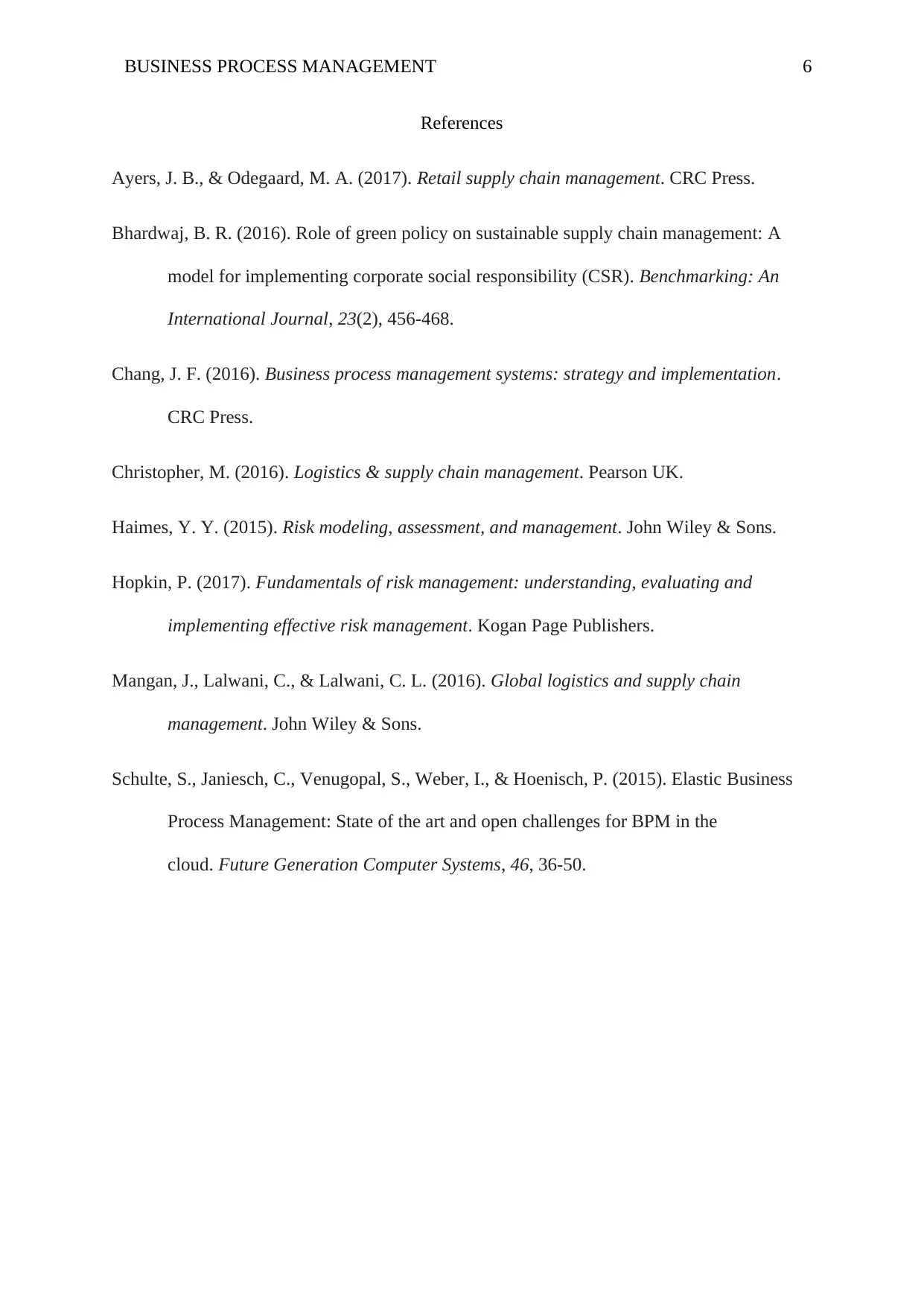
BUSINESS PROCESS MANAGEMENT 6
References
Ayers, J. B., & Odegaard, M. A. (2017). Retail supply chain management. CRC Press.
Bhardwaj, B. R. (2016). Role of green policy on sustainable supply chain management: A
model for implementing corporate social responsibility (CSR). Benchmarking: An
International Journal, 23(2), 456-468.
Chang, J. F. (2016). Business process management systems: strategy and implementation.
CRC Press.
Christopher, M. (2016). Logistics & supply chain management. Pearson UK.
Haimes, Y. Y. (2015). Risk modeling, assessment, and management. John Wiley & Sons.
Hopkin, P. (2017). Fundamentals of risk management: understanding, evaluating and
implementing effective risk management. Kogan Page Publishers.
Mangan, J., Lalwani, C., & Lalwani, C. L. (2016). Global logistics and supply chain
management. John Wiley & Sons.
Schulte, S., Janiesch, C., Venugopal, S., Weber, I., & Hoenisch, P. (2015). Elastic Business
Process Management: State of the art and open challenges for BPM in the
cloud. Future Generation Computer Systems, 46, 36-50.
References
Ayers, J. B., & Odegaard, M. A. (2017). Retail supply chain management. CRC Press.
Bhardwaj, B. R. (2016). Role of green policy on sustainable supply chain management: A
model for implementing corporate social responsibility (CSR). Benchmarking: An
International Journal, 23(2), 456-468.
Chang, J. F. (2016). Business process management systems: strategy and implementation.
CRC Press.
Christopher, M. (2016). Logistics & supply chain management. Pearson UK.
Haimes, Y. Y. (2015). Risk modeling, assessment, and management. John Wiley & Sons.
Hopkin, P. (2017). Fundamentals of risk management: understanding, evaluating and
implementing effective risk management. Kogan Page Publishers.
Mangan, J., Lalwani, C., & Lalwani, C. L. (2016). Global logistics and supply chain
management. John Wiley & Sons.
Schulte, S., Janiesch, C., Venugopal, S., Weber, I., & Hoenisch, P. (2015). Elastic Business
Process Management: State of the art and open challenges for BPM in the
cloud. Future Generation Computer Systems, 46, 36-50.
⊘ This is a preview!⊘
Do you want full access?
Subscribe today to unlock all pages.

Trusted by 1+ million students worldwide

BUSINESS PROCESS MANAGEMENT 7
1 out of 7
Related Documents
Your All-in-One AI-Powered Toolkit for Academic Success.
+13062052269
info@desklib.com
Available 24*7 on WhatsApp / Email
![[object Object]](/_next/static/media/star-bottom.7253800d.svg)
Unlock your academic potential
Copyright © 2020–2025 A2Z Services. All Rights Reserved. Developed and managed by ZUCOL.





